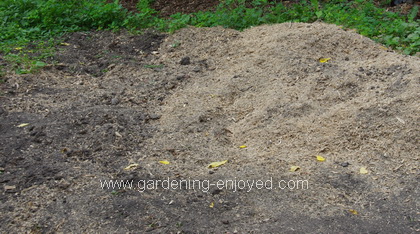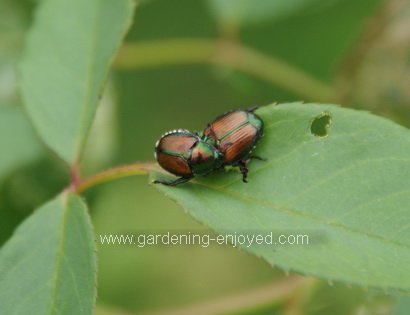
That’s a pile of woodchips you see. Why? You might ask is that newsworthy. Well it’s really not but it explains a few things. The timing of this and possibly the next issue of “Dallying”. I’m about to leave the Assistant Gardener in charge of keeping things watered and harvested for about 6 days. She will do an excellent job as she always does. I’m off to Atlanta to learn and to party. It is the annual Garden Writers conference where we wander into the hotel bar to find long time acquaintances among the many garden communicators that will be found there. We attend many seminars and wander through some wonderful gardens and then have a few meals together.
How does that explain the pile of woodchips. There is always a list of jobs that needs to be done before you leave to go away and getting that section of bare ground in the back yard, that is supposed to become grass, ready to seed was on that list. I discovered this rather large stump just under the soil
level when I last tried to even out that space. It was too hot all summer to grind it out but this week it was slightly cooler and I decided to undertake the task. The instructions on the rented stump grinder indicated that it was a very physical task and should only be undertaken by someone with the strength and endurance to manage it. Boy! Were they correct. Anyway, as you can see by the pile of woodchips the stump is now history and when I get back I can rake it out and sow that grass seed. Hopefully by then the days will be cooler and possibly a bit more moist so that the grass seed will have the perfect conditions to germinate. I will rest my weary muscles in Atlanta.
 Even more distressing than having to dig out a stump is the discovery of these two miserable beasties. They are obviously only miserable to me and not to each other but I need to interrupt their activities and kill them before they successfully create more problems. They are the infamous Japanese Beetles. I have only seen them in my garden a couple of times but today I found four quietly munching on their favourite food, roses. Not only do they like Roses but they particularly like hiding in the flower petals and enjoying them as both camouflage and lunch. That Rose bush had very little foliage left intact and the flower was rapidly disappearing. They are a rather solid creature and that allows for a very satisfying “crunch” sound when they are between my thumb and finger or the jaws of my needle nosed pliers. Manual control is probably the best method of dealing with them if their invasion is limited. There are nematodes that will attack their larva when they are in
the soil, if you can time the application correctly. There are also some effective pheromone traps but they tend to attract the beetles from quite a distance. If you can convince a neighbour 2 houses away to set up your trap, in his yard, that could be very effective in your yard.
Even more distressing than having to dig out a stump is the discovery of these two miserable beasties. They are obviously only miserable to me and not to each other but I need to interrupt their activities and kill them before they successfully create more problems. They are the infamous Japanese Beetles. I have only seen them in my garden a couple of times but today I found four quietly munching on their favourite food, roses. Not only do they like Roses but they particularly like hiding in the flower petals and enjoying them as both camouflage and lunch. That Rose bush had very little foliage left intact and the flower was rapidly disappearing. They are a rather solid creature and that allows for a very satisfying “crunch” sound when they are between my thumb and finger or the jaws of my needle nosed pliers. Manual control is probably the best method of dealing with them if their invasion is limited. There are nematodes that will attack their larva when they are in
the soil, if you can time the application correctly. There are also some effective pheromone traps but they tend to attract the beetles from quite a distance. If you can convince a neighbour 2 houses away to set up your trap, in his yard, that could be very effective in your yard.

A couple of weeks ago when I ripped the last of the Broccoli and Kohl Rabi out of the Earthboxes. I then sowed them with a variety of seeds. This box of Lettuce is almost ready to grace our salad bowls. It should continue to produce until the hard frosts start to show up in another month or more. The pak Choi and Kohl Rabi are coming along nicely and should provide some late season interest to the dinner plate. They take a bit longer than the lettuce but they will tolerate some harder frosts as well. Upon my return I will also be planting next year’s Garlic . I was speaking at the Stratford Garlic Festival last weekend and spent some time perusing the many booths there. I came home with a couple of interesting types of Garlic that
will find a spot in the garden along with the variety I usually grow. My usual is a porcelain type and I acquired a rocambole and a purple stripe to add to my collection. They are the three main types of hard necked Garlic and each type has many varieties among it. I was amazed at the quantity and variety of Garlic that was available at this festival.
Now it’s time to answer a few of my reader’s questions. Don’t forget to check the front page of the Website for frequent short ideas for current gardening activities.
John Asks? I have a very healthy Mandevilla, Brides Cascade on my patio, what can I do with it in the winter?
Ken Answers! The short answer is let it freeze and buy a new one next year. I have tried to overwinter them. They do suffer from insufficient light but mine also became so infested with spider mites that I just put the whole mess out in the
snow. If you try to keep it, cut it back to a manageable size, give it as bright a spot as possible and keep a close watch for spider mite activity.
Good luck.
Julia Asks? I have been refreshing some grown over gardens this year. Now that I have seen what has come up I want to move things around again. I would prefer to do it next week but some of the perennials I want to move are suggested to be moved in the spring instead of the fall. The ones I am concerned about are Purple Coneflower and Bleeding heart. I just want the garden to be set in place for the spring. If I move them now what will happen to them in the spring. Will they be OK? Why is the spring better to move them? I would think I could get them settled before frost and therefore have them ready for the spring.
Ken Answers! Go ahead, do it now. Some perennials will do a bit better transplanted in the spring when they are more actively growing but they will be fine if they are
done early enough in the fall. If the weather stays this hot, make sure that you keep the transplants well watered. I would also give them some transplant fertilizer to encourage new root growth. There are several, I tend to use Plant Prod 10 52 10.
Marion Asks? I have a King George daylily that has 7" to 8" blooms. This past June, we dug it up to give a piece to a friend, and put the rest back. It lots of blooms this year, but not nearly the size they were last year. When I Googled the issue I got that if you divide right before a hot dry summer, this will happen, so I'm assuming it didn't like being dug up in June. Now I'm tempted to dig it up again, divide it, and put it back with extra loving care, but I'm not sure I should. Should I assume the plant is under stress and leave it alone, hoping it makes its own recovery next year?
Ken Answers! It wasn't so much the time you did it but the weather that followed. Leave it where it
is and try to give it good regular waterings next year. Not much you can do about the heat. Many of my well established Daylilies had smaller blooms this year.
|

 Even more distressing than having to dig out a stump is the discovery of these two miserable beasties. They are obviously only miserable to me and not to each other but I need to interrupt their activities and kill them before they successfully create more problems. They are the infamous Japanese Beetles. I have only seen them in my garden a couple of times but today I found four quietly munching on their favourite food, roses. Not only do they like Roses but they particularly like hiding in the flower petals and enjoying them as both camouflage and lunch. That Rose bush had very little foliage left intact and the flower was rapidly disappearing. They are a rather solid creature and that allows for a very satisfying “crunch” sound when they are between my thumb and finger or the jaws of my needle nosed pliers. Manual control is probably the best method of dealing with them if their invasion is limited. There are nematodes that will attack their larva when they are in
the soil, if you can time the application correctly. There are also some effective pheromone traps but they tend to attract the beetles from quite a distance. If you can convince a neighbour 2 houses away to set up your trap, in his yard, that could be very effective in your yard.
Even more distressing than having to dig out a stump is the discovery of these two miserable beasties. They are obviously only miserable to me and not to each other but I need to interrupt their activities and kill them before they successfully create more problems. They are the infamous Japanese Beetles. I have only seen them in my garden a couple of times but today I found four quietly munching on their favourite food, roses. Not only do they like Roses but they particularly like hiding in the flower petals and enjoying them as both camouflage and lunch. That Rose bush had very little foliage left intact and the flower was rapidly disappearing. They are a rather solid creature and that allows for a very satisfying “crunch” sound when they are between my thumb and finger or the jaws of my needle nosed pliers. Manual control is probably the best method of dealing with them if their invasion is limited. There are nematodes that will attack their larva when they are in
the soil, if you can time the application correctly. There are also some effective pheromone traps but they tend to attract the beetles from quite a distance. If you can convince a neighbour 2 houses away to set up your trap, in his yard, that could be very effective in your yard. 
